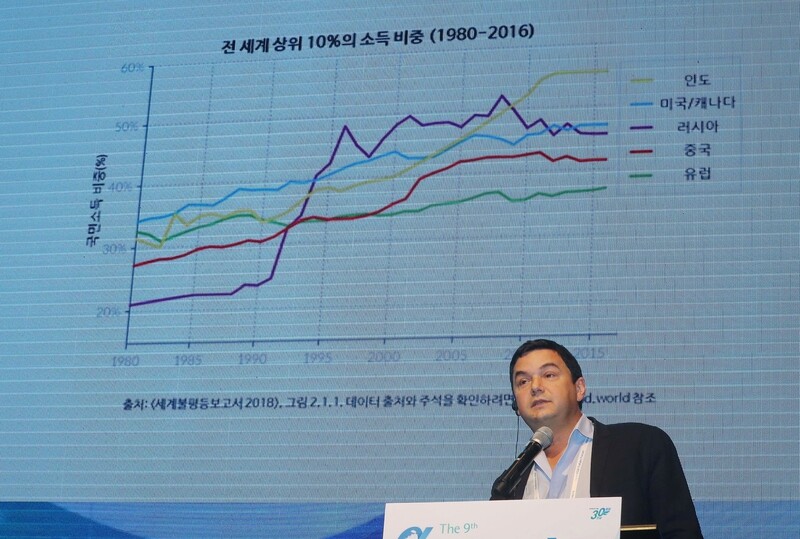hankyoreh
Links to other country sites 다른 나라 사이트 링크
S. Korea’s top 10% accounts for 43.3% of country’s income

South Korea’s top-earning 10% accounted for 43.3% of all income, representing a higher level of income inequality than almost all advanced economies apart from the US, study results show.
Inequality in assets was found to be even more than severe than income inequality, with the bottom 50% of South Koreans accounting for less than 2% of all assets – roughly one-quarter the level in France.
Additional data on South Korean income inequality indicators through 2016 were confirmed on Nov. 25 to have been added to WID.world (the World Inequality Database), a collection of income and asset inequality information for around 70 countries around the world. Data through 2013 were also added for asset inequality indicators, which had been previously absent. The resulting figures allow for comparison and analysis of South Korea’s income and asset inequality situation relative to other countries.
Considered one of the leading databases for information on economic inequality, the database includes income and asset data gathered by around 100 economists around the world, including Paris School of Economics professor and “Capital in the Twenty-First Century” author Thomas Piketty.
The database’s information on income and assets in South Korea was updated on Nov. 5 based on the paper “Income Concentration in South Korea: Update 1933–2016” by Dongguk University economics professor Kim Nak-nyeon.
“By comparing South Korea’s inequality situation with other countries, we can identify problem areas more accurately and develop alternatives,” Kim suggested.
According to the database, South Korea’s top-ranked 1% in terms of income accounted for 12.2% of all income in 2016. The percentage stood at over 20% in the 1930s before dropping in the 1970s to the 7–8% range, where it remained through the eruption of the foreign exchange crisis in 1997. It subsequently began to rise again, passing 10% in 2006 and hovering recently around 12%. The percentage was lower than those observed for the US (20.2% in 2014) and China (13.8% in 2015), but higher than those in Japan (10.4% in 2010), France (10.8% in 2014), and Sweden (8.7% in 2013).
The percentage of all income earned by the top 10% stood in the 20% range through the 1980s before passing 30% in 1995 and 40% in 2006; as of 2016, it was calculated at 43.3%. The percentage was higher than those for almost every country apart from the US (47% in 2014).
It stood in especially stark contrast with the countries of Europe, where it remains in the low to mid-30% range. In France, the percentage stood at 32.6% in 2014.
“The reason income is relatively concentrated with South Korea’s top-earning 10% is because of severe polarization among wage earners, particularly between regular and irregular workers,” Kim said.
Asset inequality was found to be even more severe than income inequality, with the top-ranked 1% and 10% for assets respectively accounting for 25% and 65.7% of all assets in 2013. In France, the respective percentages were comparatively lower at 22.9% and 54.9%. In particular, South Korea’s bottom-ranked 50% for assets accounted for just 1.8% of all assets, compared to 6.4% in France.
By Jeong Eun-ju, staff reporter
Please direct comments or questions to [english@hani.co.kr]

Editorial・opinion
![[Column] Season 2 of special prosecutor probe may be coming to Korea soon [Column] Season 2 of special prosecutor probe may be coming to Korea soon](https://flexible.img.hani.co.kr/flexible/normal/500/300/imgdb/original/2024/0426/3317141030699447.jpg) [Column] Season 2 of special prosecutor probe may be coming to Korea soon
[Column] Season 2 of special prosecutor probe may be coming to Korea soon![[Column] Park Geun-hye déjà vu in Yoon Suk-yeol [Column] Park Geun-hye déjà vu in Yoon Suk-yeol](https://flexible.img.hani.co.kr/flexible/normal/500/300/imgdb/original/2024/0424/651713945113788.jpg) [Column] Park Geun-hye déjà vu in Yoon Suk-yeol
[Column] Park Geun-hye déjà vu in Yoon Suk-yeol- [Editorial] New weight of N. Korea’s nuclear threats makes dialogue all the more urgent
- [Guest essay] The real reason Korea’s new right wants to dub Rhee a founding father
- [Column] ‘Choson’: Is it time we start referring to N. Korea in its own terms?
- [Editorial] Japan’s rewriting of history with Korea has gone too far
- [Column] The president’s questionable capacity for dialogue
- [Column] Are chaebol firms just pizza pies for families to divvy up as they please?
- [Column] Has Korea, too, crossed the Rubicon on China?
- [Correspondent’s column] In Japan’s alliance with US, echoes of its past alliances with UK
Most viewed articles
- 1[Column] Season 2 of special prosecutor probe may be coming to Korea soon
- 2‘We must say no’: Seoul defense chief on Korean, USFK involvement in hypothetical Taiwan crisis
- 3Is N. Korea threatening to test nukes in response to possible new US-led sanctions body?
- 4Division commander ordered troops to enter raging flood waters before Marine died, survivor says
- 5Amnesty notes ‘erosion’ of freedom of expression in Korea in annual human rights report
- 6Is Japan about to snatch control of Line messenger from Korea’s Naver?
- 7No good, very bad game for Korea puts it out of Olympics for first time since 1988
- 8[Editorial] Korea’s surprise Q1 growth requires objective assessment, not blind fanfare
- 9N. Korean delegation’s trip to Iran shows how Pyongyang is leveraging ties with Moscow
- 10Korea’s 1.3% growth in Q1 signals ‘textbook’ return to growth, says government